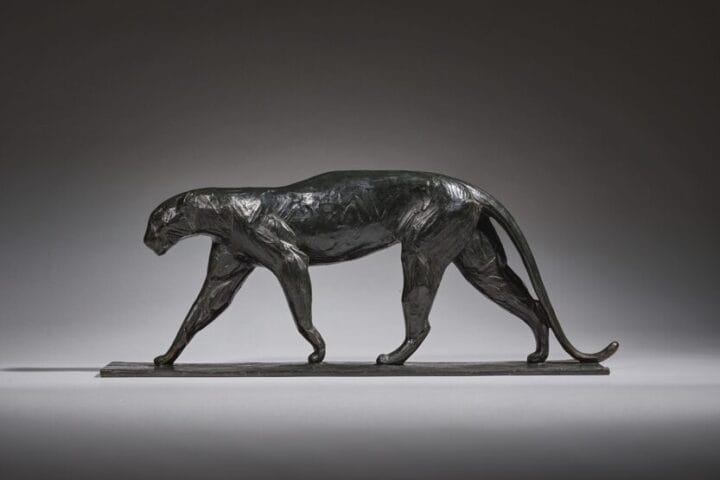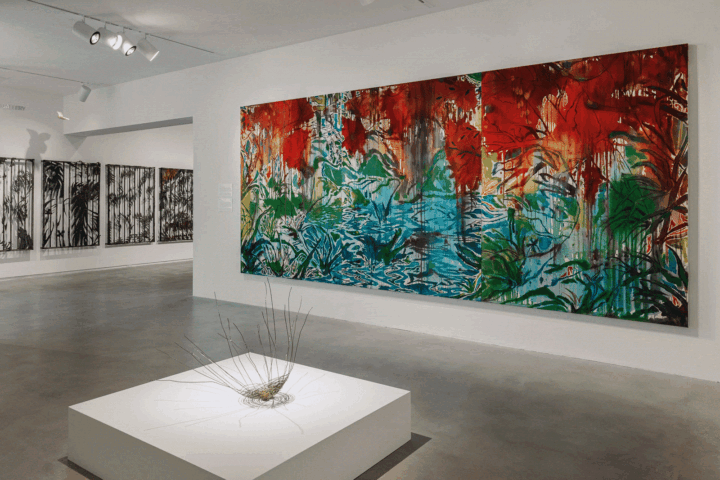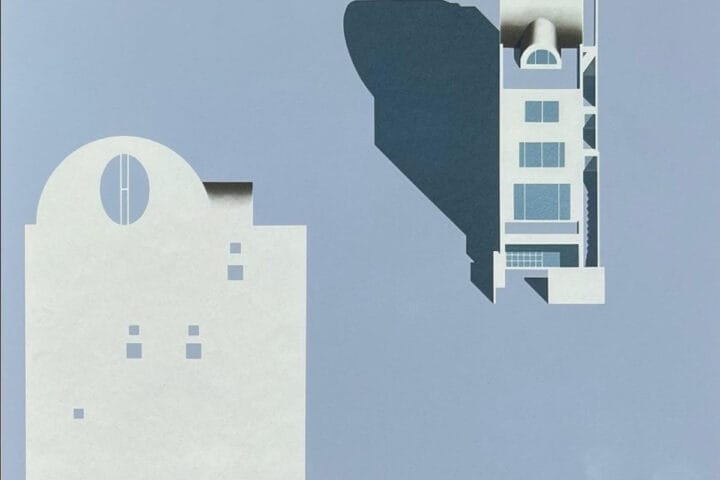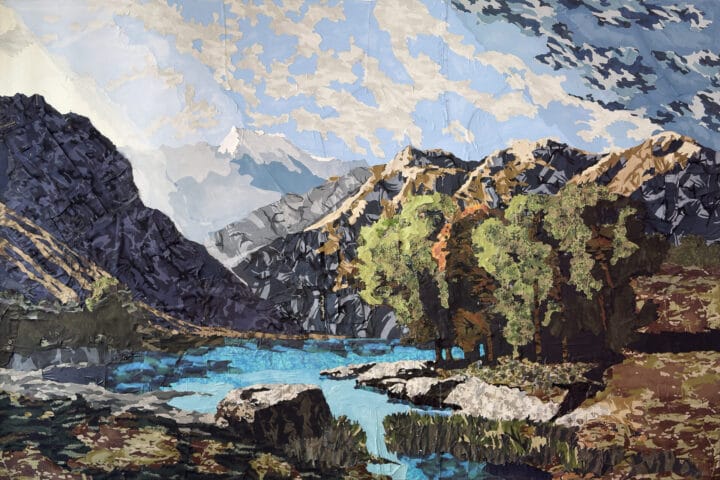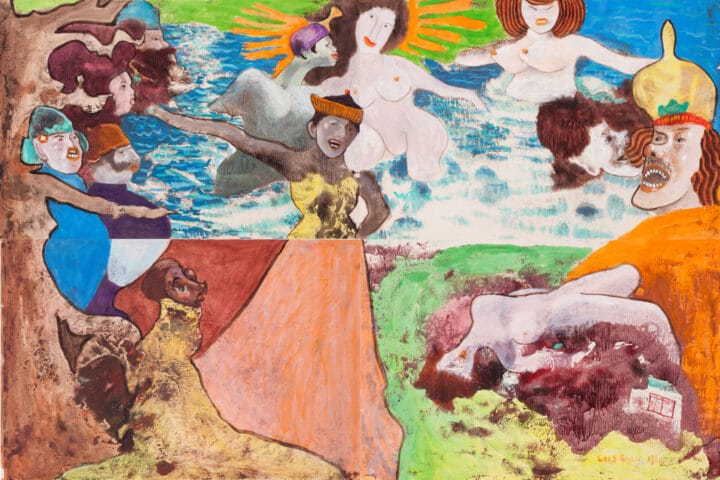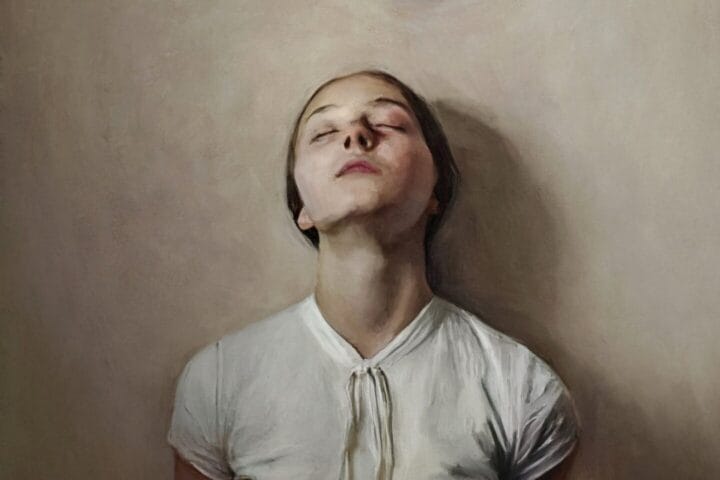A MONUMENTAL ODE TO JAZZ AND ONE OF THE ARTIST’S MOST
SINGULAR AND IMPORTANT WORKS,
TO STAR IN SOTHEBY’S CONTEMPORARY EVENING AUCTION THIS MAY
INSPIRED BY CHARLIE PARKER’S 1945 COMPOSITION OF THE SAME NAME,
THE PAINTING CONFIRMS BASQUIAT’S PLACE IN THE PANTHEON OF
BLACK ARTISTS THAT HE REVERED
ESTIMATED TO ACHIEVE IN EXCESS OF $30 MILLION
ON OFFER FROM THE COLLECTION OF PETER BRANT
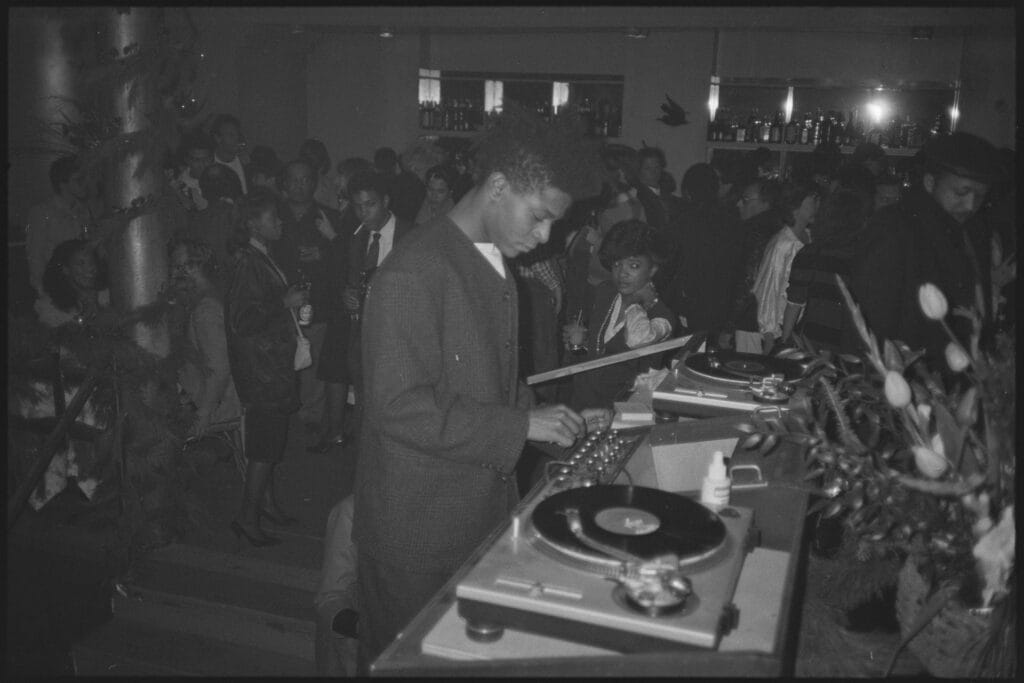
NEW YORK, 20 April 2023 — Few artists so seamlessly blend a variety of artistic practices as Jean-Michel Basquiat, whose body of work famously bridges multiple styles and incorporates elements of street art, figuration, and abstraction, all fused together to form a singular visual idiom that is among the most recognizable and revered among 20th century artists.
This May, Sotheby’s Contemporary Evening Auction will offer as a highlight Basquiat’s Now’s the Time, one of the most unique, monumental works from the artist’s career–measuring more than 7 feet in diameter. Anticipated to achieve in excess of $30 million, the work comes to auction for the first time in the nearly 40 years since it was created, having remained for several decades in the renowned collection of Peter Brant, the sole collection where the painting has resided to date.
“That’s what I see in the paintings and the drawings. Bigger than life. Living large life. Moments still radiant with thought and feeling. Everything that came from his hand is alive, giving off rays. It’s like that Charlie Parker song, “Now Is the Time.”
Glenn O’Brien, “Basquiat: The Show Must Go On,” 17 September 2013
Now is always the time. Boom. Boom for real.”
As a recreation of the vinyl pressing of musician Charlie Parker’s 1945 composition Now’s the Time, the painting is the ultimate expression of Basquiat’s passion for music and the way it fundamentally impacted his practice. Now’s the Time immortalizes Basquiat’s idol Parker, the legendary jazz saxophonist whose trailblazing and revolutionary style would define the post-war bebop sound, who also represented the spirit of freedom and improvisation that became hallmarks of Basquiat’s own practice. The painting also exemplifies the greater recognition and admiration of Black artists, past and present, that was so central to Basquiat’s own artistic practice. In his homage to Parker, Basquiat praises the jazz great as an important creative predecessor and an artist who valiantly forged his own creative path within the context of Jim Crow-era America.
Basquiat’s love of classical music and jazz, inspired by his father, deeply influenced not only his approach to painting, but was also a major component in nearly every aspect of his life. At the forefront of New York’s vibrant and fertile downtown scene of the late 1970s and early 1980s, Basquiat was exposed to a cacophony of emergent music styles, from the avant-garde of No Wave as member of the band of Gray to the burgeoning Hip Hop scene. Basquiat’s explorations into these different strands of music would see him make an appearance as a DJ in the Blondie music video for “Rapture” as well as collaborate with artist Rammellzee to produce the highly influential Hip Hop record “Beat Bop” in 1983. All of these elements would inform the way music would deeply influence his oeuvre, from references to musicians and albums throughout his paintings to impacting the foundation of his technique as a painter and the way he approached compositions.
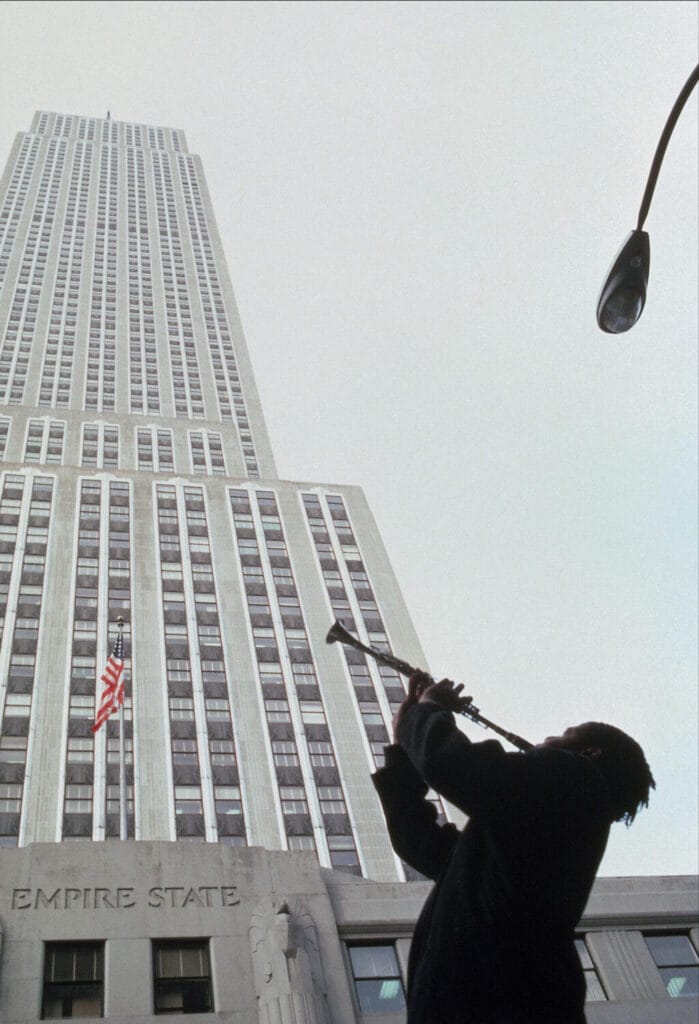
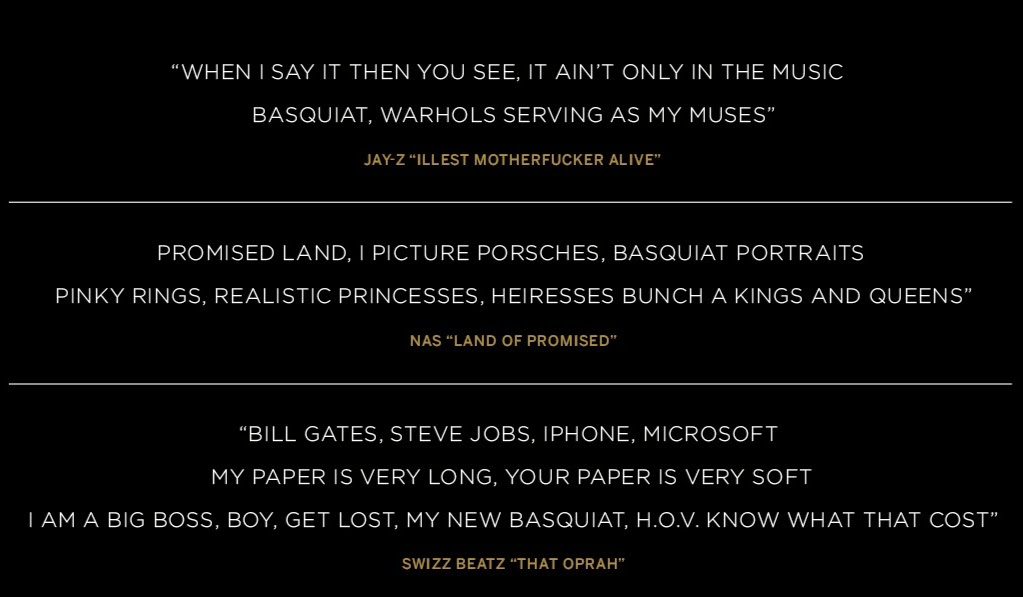
The musical vein runs not only through Basquiat’s life and work, but also in his legacy as a source of inspiration and influence for music artists today. In the way that Basquiat lionized Parker in Now’s the Time, generations of hip hop artists, from JAY-Z to Nas, routinely namecheck Basquiat not only as a stylistic reference, but as an aspirational symbol given the artist’s vaunted place within the cultural pantheon. In the years since Basquiat’s death, his art and legacy have become firmly ensconced in the cultural mainstream and continues to inspire artists outside the bounds of painting with his genre-defying style.
NOW’S THE TIME
JEAN-MICHEL BASQUIAT
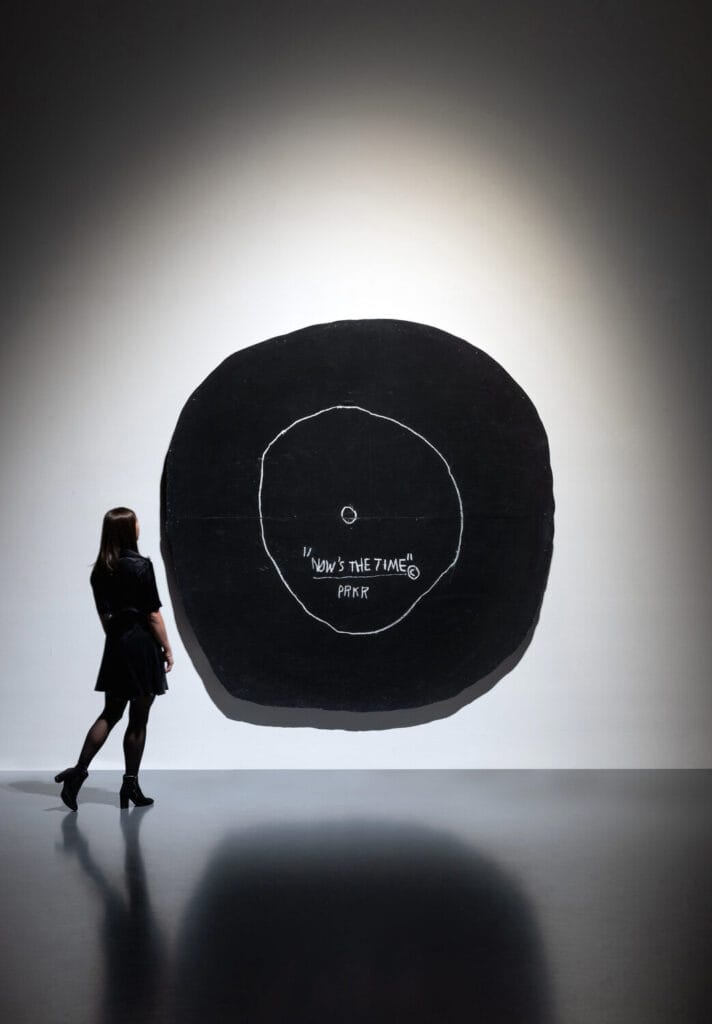
“MUSIC IS BASICALLY MELODY, HARMONY, AND RHYTHM. BUT PEOPLE CAN DO MUCH MORE WITH MUSIC THAN THAT.”
CHARLIE PARKER
Executed in 1985, Now’s The Time announces Basquiat at the absolute apex of his international success as an artist, when he was also the center of New York’s creatively exploding downtown art scene. As Basquiat’s most visually simplistic and mature masterpiece, Now’s the Time witnesses Basquiat radically pare down the explosive bravura of his street art-based paintings into an austere composition that replicates a vinyl record pressing, with only a few inscriptions scrawled upon the black matte surface.
In addition to its reference to Charlie’s Parker’s 1945 composition, the emphatic exclamation of the painting’s title calls immediate attention to this moment of Basquiat’s career when his star shined brightest and there was seemingly nothing he could not accomplish as an artist. Today, this phrase, which has become a familiar slogan within the scholarship and cultural vernacular for the artist, holds more resonance than ever before, as Basquiat’s artistic vernacular is so universally familiar within popular culture.
Though Basquiat once referred to Miles Davis as his favorite musician, it was Charlie Parker who ultimately figured as his all-time personal hero. In many ways Parker’s career trajectory paralleled Basquiat’s. Parker’s brief recording career lasted only one decade from 1945 to 1955, and he was a largely self-taught saxophonist. Pioneering the jazz style of bebop that is best exemplified by the sonic rhythms of the eponymous composition, Parker was uncompromising in his revolutionary sonic complexity that synthesized an inventively fast tempo, alternating chord progressions, and above all else, an undying freedom of improvisation. The modernity of the bebop sound that Parker innovated, as well as the urgency of ending racial segregation in the wake of World War II through which he lived, are both no better suggested than in the call to action behind the present composition’s title: “Now’s The Time.”
Beginning in 1983, Basquiat began to focus on jazz as a central subject of his work and would go on to produce more than thirty paintings in tribute to saxophonist Charlie Parker alone. In Now’s the Time, Basquiat transforms Parker to the shorthand “PRKR,” creating an updated persona for the jazz legend that mirrors Basquiat’s street tagging alter-ego SAMO, drawing an unmistakable parallel between the two artists and binding their artistic legacies. As a final touch, the artist emblazons his signature copyright sign upon the surface of the painting, both as a means of giving credit to Parker and marking the painting and declaration as his own.
With Now’s The Time, Basquiat reconfigures the familiar form of a vinyl record into an abstract composition that more closely resembles a black hole in size and scale, as the painting is composed on a large, roughly cut plywood disk that immediately absorbs the viewer into its mass. Basquiat’s austere white-on-black technique is restrained yet elegant, possessing a beauty and stillness that evoke the rigors of Minimalism while preserving the urban grit and energy of the artist’s downtown New York environs. The work builds upon the conceptual practices of artists such as Jasper Johns, and radically destabilizes the boundaries of painting, sculpture, and object in a poignant interpretation of the cultural symbolism and context behind Parker’s music.
While abstaining from the expressionist fury normally associated with Basquiat’s paintings, the irregular shape of the work maintains the profound tension pervading most of his oeuvre. Rejoicing in the Black male jazz musicians with whom Basquiat discovered his unique style, Now’s the Time creates a monument to Basquiat’s legendary career and influence that resounds today with visual artists and musicians who continue to amplify his voice and find inspiration in the depth of his body of work and life. With three words, Basquiat declares his place amongst the pantheon of Black artistic icons he admired, claiming the moment as his own and immortalizing the significance of his then radical, now canonical artistic project: Now’s the Time.
Testifying to its significance in Basquiat’s oeuvre, Now’s the Time has appeared as a major highlight in many of the Basquiat’s most acclaimed international exhibitions and retrospectives, including those at the Brooklyn Museum, New York; Fondation Beyeler, Basel; and Art Gallery of Ontario, where it was the centerpiece of the eponymous exhibition entitled Jean Michel Basquiat: Now’s the Time, and most recently, in the landmark exhibition at Montreal Museum of Art, Seeing Loud: Basquiat and Music, where it was prominently illustrated on the cover of the exhibition catalogue.
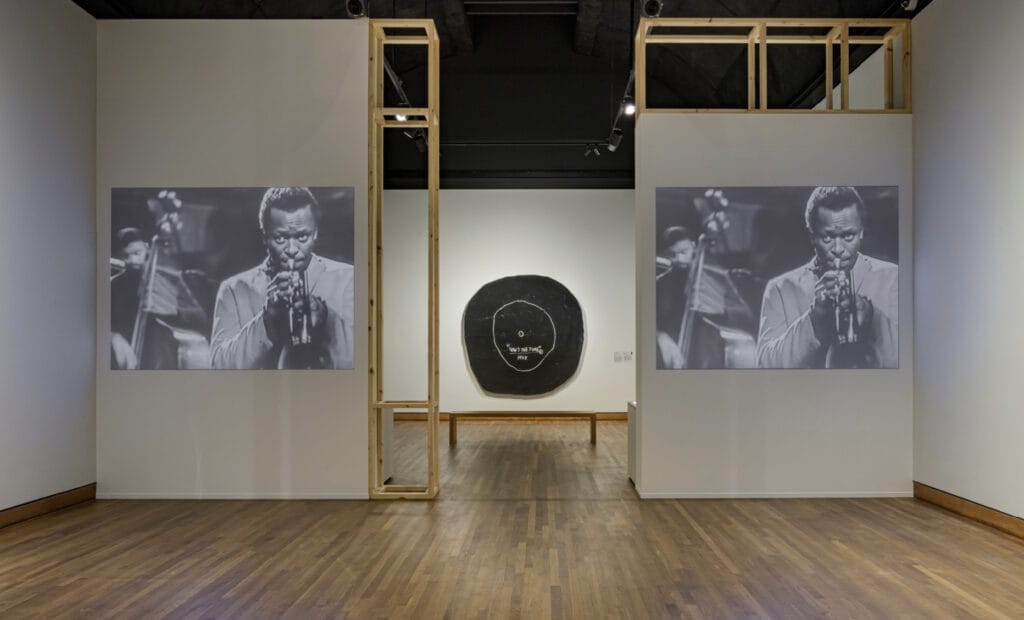
EXHIBITION DETAILS
Los Angeles: 20 — 24 April
New York: 6 — 18 May
AUCTION DETAILS
New York
Contemporary Evening Auction
Thursday, May 18
7:00 PM EST


